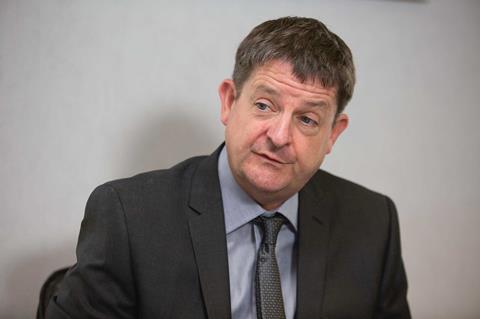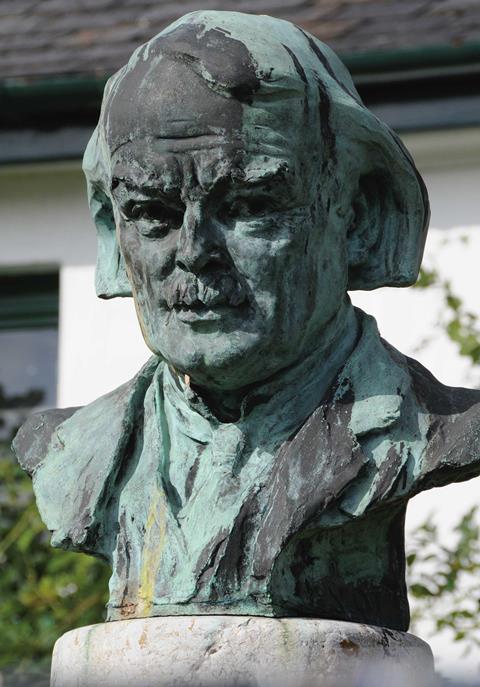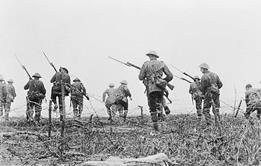To mark the centenary of the first world war, we look at the experiences of solicitors who served on all fronts. Some of these accounts were previously unpublished.
At 7am on Monday 3 August 1914, the dining room at the First Avenue Hotel, High Holborn, London, filled with khaki-uniformed young men calling for huge fried breakfasts and the latest editions of the morning papers.
The 230 members of the Inns of Court Regiment (‘The Devil’s Own’) had been on the go for 24 hours, after setting off from London the previous morning to Salisbury Plain for their annual training camp, only to be recalled on arrival as the international crisis deepened. Thanks to a rail service we can only envy in the 21st century, the territorial regiment arrived at Addison Road station, Kensington, at 5.30am on the Monday, a bank holiday.
‘We marched to our headquarters at Lincoln’s Inn, along deserted streets in the beautiful summer morning, and dispersed in search for breakfast,’ commanding officer Lt-Col Francis Errington recalled in the regiment’s official history.
At the First Avenue (whose site is today occupied by the Principal Registry of the Family Division), exuberant part-timers probably called for brandies-and-soda, too. Like so many social innovations, from air travel to the admission of women to the legal profession, the Intoxicating Liquor (Temporary Restriction) Act lay in a future about to be ushered in by the first world war.
The next day, at 11pm London time, Britain was at war and the Inns of Court Regiment was mobilised to begin its wartime job: training gentlemen private soldiers – many with connections to the legal profession – to become officers for Britain’s new armies.
Contrary to later myth, the declaration of war was not treated as a jingoistic national celebration, in the legal world at least. On 8 August, a weekly newspaper, the Solicitors’ Journal and Weekly Reporter , commented: ‘Europe in its madness has determined on a general war, and Great Britain, owing to one compelling fact [Germany’s invasion of Belgium] has become involved.’
The Law Society’s Council, meanwhile, voted to offer the Law Society’s Hall to the British Red Cross Society for use as a hospital. It also agreed to abandon a provincial meeting planned to take place in Hereford in September. It felt necessary to state: ‘The council feel sure that all members of the profession will be anxious to encourage all their clerks of military age at the present serious crisis to join one or other of the defensive forces of the country.’
Such encouragement turned out to be unnecessary. On the first day of hostilities, 20-year-old Henry Peake, articled to his father, HA Peake of Sleaford, Lincolnshire, signed up with the Inns of Court Officers Training Corps (OTC), the first of many. On 10 August the OTC advertised in The Times for 2,000 volunteers. It was inundated.
Over the next four years, thousands of solicitors, articled clerks, barristers and other gentlemen assessed as being officer material – one in 10 of those who applied – passed through the OTC’s ranks before being commissioned, overwhelmingly into infantry battalions. One who answered the call was Guy Clifton Davis, articled to HJ Shepard, of 40 Chancery Lane, who spent the next few months in the OTC’s camp in Berkhamsted, Hertfordshire, before being commissioned into the Northumberland Fusiliers, the ‘Fighting Fifth’, at the rank of second lieutenant.
However, a commission through the Inns of Court Regiment (which is still active) was by no means the only route by which some 7,000 solicitors and articled clerks found their way into khaki or navy blue. Solicitors are lucky to have a unique account, the Record of Service of Solicitors and Articled Clerks in His Majesty’s Forces, published just after the war. It runs to 630 pages, each listing about 10 names, followed by between two and 12 lines of information, including date of admission or to whom articled, date of joining the forces, unit, rank, and where service took the lawyer.
On a typical page, three or more entries include a terse line about wounds, disease, shell shock or death. A large proportion are identified as ‘articled to’ a solicitor with the same surname, usually their father. Sometimes the surnames recur in poignant combinations.
Solicitors joined at all ages. While a majority were in their early 20s, Henry Auty of Auty & Sons, Sheffield, served as a lieutenant despite being admitted in May 1879. His near contemporary, Charles Greenwood, admitted in 1878 and member of Greenwood & Greenwood, Temple, was mobilised as paymaster, Royal Naval Volunteer Reserve. This City gent, well into his 50s, ‘accompanied the Troops’ on Winston Churchill’s quixotic 1914 expedition to save Antwerp from the German advance.
Alexander Arnold Hannay, admitted in November 1881, and practising at 5 Albemarle St, served with the French Red Cross, winning the Croix de Guerre aschef adjoint, Convois d’automobiles. (An 1896 portrait, by James McNeill Whistler, hangs in the National Gallery of Art, Washington DC.) His firm is now City firm Reynolds Porter Chamberlain.
They served in all ranks: the highest proportion of solicitors became junior officers, starting as second lieutenants leading a platoon of 30 or 40 riflemen. Statistically, this was the most dangerous rank, and casualties were correspondingly high. Overall, of the 17 ‘gentlemen applying to be admitted as solicitors of the Supreme Court’ in August 1914, nine were to go into the army and three to die on active service. This compares with the overall death rate of 8% of British servicemen in the war.
I felt that I had been kicked by an elephant. Before losing consciousness I felt a bullet graze the palm of my hand and a piece of grenade pierce an eyelid
Henry Lawson, who survived and became a president of the Law Society in the 1960s
Many, however, signed up at the humblest rank. Gloucester solicitor Frederick William Harvey joined the Gloucestershire Regiment as a private on 8 August 1914. A few days later, Wilfred Thomas de Berdewelle Barwell, evidently a gentleman with his own Seaford firm, joined as a private in the Royal Fusiliers. Frank Howard Butcher, admitted in 1910, of ‘Slaughter & May [sic], 18 Austin Friars EC’, served as an ordinary seaman in the Royal Navy.
On the other hand, St Barbe Russell Sladen, admitted in 1895 and mobilised in August 1914 as a major in the Royal West Surrey Regiment, was killed at Passchendaele in 1918 while acting as a brigadier general in charge of some 4,000 men. Cecil Henry Whittington, admitted in April 1901, and practising at Queen Anne’s Chambers, rose to the same rank in the Royal Flying Corps.
They came from far and wide. Many, such as Harry Colin Clarke, admitted in 1903, returned home from Canada in 1914 (he was killed in 1916). Leo Burton Feeny, of Boston, Massachusetts, admitted in 1901, served with the McGill University Overseas Corps. John Hellard, admitted in 1906, was practising in Colombo, Ceylon (now Sri Lanka) when he joined the Somerset Light Infantry in 1915. He was killed on the first day of the Battle of the Somme. John Leslie Thomson, admitted in 1911, was with the Royal Indemnity Co in New York but joined the Canadian Army. He seems to have survived being ‘shot by sniper’ in 1916.

Kinsmen and colleagues joined together. Three members and articled clerks of the Newcastle upon Tyne firm Gibson, Pybus & Pybus joined up; one was killed in a motorcycle accident at home after being wounded in Flanders. Two members of Raley & Sons of Barnsley served: William Emsley Raley, qualified in 1881, was mobilised in August 1914 as a major in the 13th Battalion, Yorks & Lancs Regiment (see below). His managing clerk and son, William Henry George Raley, was mobilised in the regiment’s third battalion and killed at Givenchy, France, in 1915.
While the infantry had the greatest need of men, solicitors served in all arms. Despite the appalling casualty rate, many young lawyers were attracted to the Royal Flying Corps. The Record of Service includes some colourful details of their fates: ‘Crashed after collision in mid-air Easter Sunday 1917’ … ‘Attacked by several enemy aircraft and forced to the ground in the German lines’ … ‘Shot down out of control’.
Rowland Wynne Frazier, admitted in 1912, survived being shot down in his Henri Farman biplane off the coast of Bulgaria in 1916 but Edgar Henry Collison ‘died from the results of a flying accident’ in Norfolk, in the same year. Maurice Pulliblank, admitted in 1905 and practising in Merthyr Tydfil, joined the Royal Flying Corps as a ‘3rd air-mechanic’. He evidently showed an aptitude – he was eventually promoted to 1st air-mechanic and after the war rated as leading aircraftsman in the newly formed Royal Air Force.
Some lawyers’ stories seem to come straight out of the works of John Buchan. Jack Valentine Hay, articled in Bloomsbury, who joined the intelligence corps on 5 August 1914, was a despatch rider at the Battle of the Marne and picked up the Legion d’Honneur for ‘contre espionage’ work for the French before transferring to the Royal Flying Corps.
James Harris, articled to his father in Winchester, was mobilised in August 1914, went to France and Mesopotamia (Iraq) where he was ‘taken prisoner by Turks at Fall of Kut el-Amara April 29, 1916, escaped from prisoners’ camp in Asia Minor 7 Aug. 7, 1918. Trekked 350 miles to coast of Asia Minor, captured Turkish tug (motor) and crossed to Cyprus 100 miles, arrived there Sept. 13, 1918’.
The Great War was a war like none before – few were prepared for what it would bring. By November 1918 the world mourned the loss of over 10.5 million soldiers and almost 5 million civilians. It was a watershed moment. For one of the first times in history, ordinary people called for a set of international laws to stave the threat of invasion, protect civilians from the horrors of war and bring a semblance of morality to the battlefield.
World leaders responded and, following the Treaty of Paris in 1919, the League of Nations was established. Its purpose was to seek to prevent conflict through collective security, disarmament and by dispute resolution in the newly established Permanent Court of International Justice. Max Huber, a Swiss lawyer, became the court’s first judge. Sixty countries signed up but there were three notable absences: the US, Russia and Germany. The first two chose not to join, the latter was told it could not do so.

This initially showed some promise. In 1919 Poland and Czechoslovakia were in dispute in respect of Teschen, a coal-rich area. In 1920 the league heard the case and decided to split the land in question. While neither country was pleased, they accepted the decision. The provision of a clear and fair legal remedy proved a useful tool in dampening the flame of potential conflict.
In 1925 a treaty prohibiting the use of biological and chemical warfare was agreed. It was registered by the league in 1929 alongside the third Geneva Convention which promised prisoners of war a minimum quality of treatment, as well as protection for aircraft and ships carrying medical supplies.
The world seemed to have entered an age of peace. History, however, teaches us that it was just an illusion. The league’s close connection to the Treaty of Versailles meant Germany treated it with suspicion. Although Germany became a member of the League of Nations in 1926 it left in 1933, claiming that disarmament was being used as a tool to prevent it obtaining military parity with other powers.
As tensions grew between western Europe, Germany and its allies, it became increasingly clear that the dispute was not going to be resolved in the courts. By December 1939 the league had ceased to exist in all but a legal sense as the world entered six more dark years with the second world war. It had failed its raison d’être and the guillotine finally fell in 1946 when it was replaced by the United Nations.
Despite the failure, the creation of the League of Nations was an important first step in institutionalising international affairs and promoting arbitration over war. It is now clear that it took one world war to make us realise we needed international dispute resolution, but a second to make the much needed progress.
The Great War touched every family – mine is no exception. My paternal grandfather was in the Royal Engineers. Fortunately he carried out much of his service in India. He survived, but one of his sons, Arthur Caplen, died in the 1939-1945 war.
The Law Society’s library records that in excess of 7,000 solicitors and articled clerks served during the conflict. In the Reading Room at Chancery Lane, London, a war memorial lists the names of the 565 solicitors and 341 clerks who gave their lives. One of those names is Cecil Harold Sewell, an articled clerk and the only member of the Law Society to be awarded a Victoria Cross in the war.
We must never forget those who gave their lives. And ensure that we learn the lessons from the past.
Andrew Caplen, president, Law Society
Of course, many solicitors found what looked like cushier billets, denoted by the phrase ‘Served at Home’. Arthur Edward Chevalier, admitted in 1887, found himself as staff adjutant at Knockaloe Alien Prisoners of War Camp, Isle of Man, which by the end housed more than 20,000 internees and prisoners.
Some at-homers evidently felt the need to rebut any suggestion of shirking, with entries full of such phrases as ‘Discharged 18 July 1917, after three months in hospital’ … ‘Discharged owing to illness and subsequently rejoined’ … ‘Engaged for foreign service but in consequence of injuries received on manoeuvres was forced to serve at Home for whole period’.
Home service was irksome for some. Inns of Court veteran Lt Cyril Shakespear Beachcroft was commissioned in the Dorset Yeomanry in October 1914 but kept at home to train others. The Record of Service notes that he transferred to the Household Battalion as a temporary lieutenant on 1 July 1917 ‘in order to get to the front’ and was killed three months later, aged 32. He lies in Poelcapelle Cemetery, Flanders, among 7,478 comrades: 6,321 of the graves are unidentified.
Home service was not necessarily without peril. Sir Augustus Montague Bradley, admitted in 1888, found himself in the thick of the Dublin Easter Rising as an artillery officer. Another unfortunate ‘died of spotted fever in Fulham Military Hospital’ on 3 May 1917. Even the Inns of Court’s Regimental HQ in Chancery Lane became a casualty on the night of 18 December 1917, when a bomb from a German Gotha aircraft shattered windows and pockmarked the stonework (the damage is still visible).
It would be nice to think the building was deliberately targeted for its contribution to the war effort, but the hit was almost certainly accidental – the brave German crew had achieved a notable feat of airmanship by finding inner London, let alone any particular target.
The first legal fatality of the war occurred at home: Edward Molyneux Cohan, articled to GM Magee, Liverpool, was killed on 5 August 1914 ‘as the result of an accident during mobilisation, when on duty on Salisbury Plain’. The first lawyer to die in action may have been Denys Ainslie, articled to his father, in Surrey Street, London, or Cyril Montagu Pope, articled to RB Pope of Brighton. Ainslie was killed in action on 24 October 1914 at the first battle of Ypres, Pope died of wounds on the same day.
Their deaths inaugurated the monthly ‘Roll of Honour’ in the Gazette’s news pages, which was to appear every month for more than four years. For the first two years it typically contained half a dozen names, but in August 1916 it leapt to three-and-a-half pages.
Almost every page of the Record of Service notes a solicitor or articled clerk killed or wounded at the Battle of the Somme. Among those killed on the British army’s bloodiest day were ‘Stephen Oswald Sharp, articled in Rotherham, Joined 11 September 1914, 12th Battalion York and Lancaster Regt. Killed in action 1 July 1916… John George Todd, member of Maughan & Hall, Newcastle upon Tyne, joined August 1914, commission in Tyneside Scottish, killed as a captain at La Boiselle 1 July 1916… Frank Smith Brooks, articled to A.P. Brooks of Southport. 2nd Lt, 20th battalion Manchester regiment, killed in action France 1 July 1916… Louis Frederick Byrne, articled in Newcastle upon Tyne, 2nd Lt Northumberland Fusiliers November 1914, killed in action in Somme battle 1 July 1916’.
Also among the battle’s casualties was Henry Peake, who had joined the Inns of Court OTC on that balmy August day in 1914. The Record of Service notes he was reported missing on 3 July ‘near Oilliers, in advance on the Somme, and subsequently reported killed in action on that day’. He was the third of three brothers to die between the ages of 22 and 25.
One solicitor has a special connection with that day. Barnsley lawyer and mine owner Sir Joseph Hewitt, admitted in 1893, was the driving force behind, and first colonel of, the 13th battalion York and Lancaster regiment, one of the local new army battalions raised following Lord Kitchener’s iconic call for volunteers. The unit is better known as the ‘Barnsley Pals’.
Hewitt was not fit to go with the battalion overseas, but on their departure toasted ‘the finest lads you can have. We are proud of them – proud of them, one and all’. On 1 July 1916 the ex-miners, who had joined up together and trained together, walked ‘in parade-ground fashion’ together into the German machine guns at Serre. The battalion suffered 275 casualties out of 700 men. The subsequent arrival of War Office telegrams at house after house in the same little streets created the abiding folk memory of the war.
Hewitt, who died in 1923, submitted only a single line to the Record of Service : ‘Served at home’. But listed just above him on the page, his articled clerk gets five lines: George Alfred Guest Hewitt was mobilised in August 1914 and wounded at Ypres and the Somme before being killed in Bourlon, near Cambrai, on 2 November 1917. He was Sir Joseph Hewitt’s son.

Solicitor officers frequently found themselves administering military justice, as members of courts-martial, specialist court martial officers, or ‘prisoners’ friends’. As part of their training all officers would have been expected to digest the Manual of Military Law . The legally qualified would have found the 900 pages of the fifth edition a breezier read than previous textbooks, with its emphasis on anecdote rather than statute.
The distinction between absence without leave and desertion, for example, is illustrated by the contrast in intention between a soldier ‘who has been entrapped into bad company through drink’ and one ‘found in plain clothes on board a steamer starting for America’. A lengthy section on when a junior officer may order the arrest of a senior must have been the subject of some interest, especially as the precedent cited was the 1819 case of a captain arresting his colonel for ‘being drunk on duty when under arms’.
Notoriously, field general courts-martial passed capital sentences on 3,080 occasions between 1914 and 1920, and 346 executions were carried out. Contrary to legend, only 18 were for cowardice and two for sleeping on duty (a pair of sentries who had apparently colluded), and while there were miscarriages, pains seem to have been taken to conduct trials properly by the standards of the time.
The accused could pick any individual they liked as defending officer, who had to take the job unless there was good reason otherwise. Avuncular individuals with legal expertise were obvious choices: Louis Crispin Warmington, a 40-year-old London solicitor serving in the Durham Light Infantry, acted as a prisoner’s friend in a notorious series of capital cases, including the trial of Sgt Joseph William Stones, on Christmas Eve 1916.
The council feel sure that all members of the profession will be anxious to encourage all their clerks of military age at the present serious crisis to join one or other of the defensive forces of the country
Law Society Council, August 1914
Stones was charged with ‘when on active service shamefully casting away his arms in the presence of the enemy’. He was the only soldier to be charged with the offence on the Western Front, and was shot at 7.35am on 18 January, a week after his sentence was confirmed by the commander-in-chief. Two lance corporals were shot with Stones; four privates also sentenced to death had their sentences commuted to 15 years’ penal servitude.
Warmington went on to become an authority on divorce law and also wrote a standard commentary on the laws of England. He seems to have left no record of his experience as a prisoner’s friend.
Many entries in the Record of Service note wounds, physical and mental. Basil Cozens-Hardy, admitted in 1911, of Cozens-Hardy of Norwich, was wounded (‘leg amputated’) near St Quentin in 1918. Charles William Buckwell of Brighton, admitted in 1906, ‘suffered from shell shock 15 April 1918.’ Many entries record ‘gassed’: that was the fate of Leslie Chessborough Fleetwood Nash, admitted in 1909 and a member of Wood, Nash, Hewlett and Riddett of Gray’s Inn, after more than four years of frontline service.
Henry Lawson served on the Western Front for two years before being severely wounded in October 1918 while leading his platoon in an assault on a German machine gun post. ‘When just a few yards away I found uncut wire and having fired my rifle from my hip at the gun’s flash I put one leg over the wire. Then it happened. I felt that I had been kicked by an elephant. Before losing consciousness I felt a bullet graze the palm of my hand and a piece of grenade pierce an eyelid.’ He survived, to become a president of the Law Society in the 1960s.
Perhaps the most tragic cases were the many whose fates were unknown: John Cecil Caster Thompson, managing clerk with Blundell, Baker & Co of Serjeant’s Inn, London, was ‘reported missing, believed killed’ on 31 January 1915.
The Roll of Honour continued long after the war. Vernon Spencer Wilkins, articled to SE Wilkins of Aylesbury, enlisted in 1915 as a private, served in France and Italy, and was wounded twice before dying of influenza on 11 November 1918, Armistice Day. One of the last to be killed on frontline active service was John Victor Card, admitted in 1911, managing clerk with Wm G Card of Cheapside, who enlisted in September 1914 as a private and saw action in France, Salonica, East Africa and Russia. He was killed in action near Archangel on 25 March 1919.
Of the early recruits to the Inns of Court OTC, Guy Davis almost made it. He reached the front in the run-up to the second battle of Ypres, famous for the first use of lethal gas as a weapon. An extract from the battalion’s war diary for 26 April reads: ‘The battalion moved up into the firing line… the men advancing at the double in extended order. The battalion suffered heavy casualties until it gained the shelter of [a] trench.’
Davis survived, to gain his second shoulder ‘pip’ as a first lieutenant and a 1-shilling rise in his daily pay, to 8 shillings and 6 pence (42.5p). On 22 June 1916 the battalion recorded ‘a quiet day in the trenches’, but in September that year it took part in the latter stages of the Battle of the Somme. With soldierly understatement, the battalion diary describes a desperate attack in the bloodbath of High Wood: ‘The enemy directed a very heavy machine gun fire… This to a certain extent broke up our orderly lines.’
A year later the Northumberlands went over the top again, in the fight for a Belgian hamlet, Passchendaele, whose name would become synonymous with the war’s horror. Davis seems to have survived all that, though he was invalided twice home with trench fever, only to be wounded in April 1918 in the British counter-attack to the final German offensive of the war.
The fact he was held at a forward casualty station rather than being evacuated suggests he was not expected to live, but he hung on for three weeks. He was 23, and the second son of Dr Robert and Ellen Davis, of Orpington, Kent, to die in the war. He lies in the beautiful little Commonwealth war cemetery in Wavans, alongside 40 comrades and three Germans.
The lucky ones came home to get on with their lives. Frederick Harvey was repatriated after two years in prisoner of war camps and resumed his practice as a solicitor, specialising in protecting penniless defendants from incarceration.
Geoffrey Stuart King, an articled clerk who joined on 8 August 1914 as a private and served throughout the war, winning the Military Cross, rose to the rank of permanent secretary in the civil service, and was awarded a KCB and KBE. When he died at the age of 87, his Times obituary noted that his 1918 wound had left him with intermittent deafness, but that had been no barrier to his career: ‘His triumph over this disability was complete.’
At the age of 80 Henry Lawson was able to write: ‘Those were happy days of fellowship and camaraderie despite the tragedies. I am eternally grateful that so much opportunity was given to me to undertake duties which, looking back, were very risky, yet presented me with a guide for later life, of enduring value and influence upon my career as a professional man.’
- The Gazette would like to thank the readers who sent in information about solicitors in the first world war, especially Emma Stuart King, Freddie Lawson, John Scott and Stewart Simpson. Thanks also to Teresa Davies of the FW Harvey Society and Emma Harris, Law Society librarian.

Visit the Law Society Gazette’s new website, Extraordinary service: solicitors in the Great War, which includes a searchable version of the Record of Service, individual war stories, galleries and memoirs. We welcome readers’ contributions about solicitors in 1914-18 and wider legal aspects of the war.
Topics
First world war: record of service

To mark the centenary of the first world war, we look at the experiences of solicitors who served on all fronts. Some of these accounts were previously unpublished.
 Currently
reading
Currently
reading
First world war: record of service
- 2
- 3
- 4
- 5
- 6
- 7













































1 Reader's comment